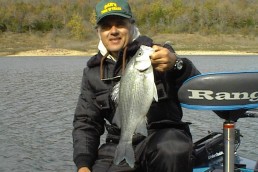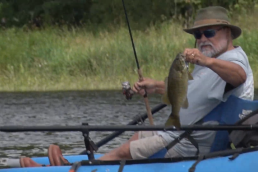Looking for White Bass on the Illinois River
SHARE THIS POST
Years have passed since the last, strong white bass run on the Illinois River. Asian carp have likely eaten much of the food for newborn whites. Hopefully, efforts to net this dominating invasive species will show results in terms of a successful spawn. Fall fishing showed the presence of a small adult white bass population which may be a base for spring fishing as well as successful spawn.
Several creeks enter the river from Morris to Henry. Whites seem to love currents that run into each other. The inflow has created gravel areas. Current speed may be less than in the river. Minnows get chased shallow by whites feeding up in preparation for dropping their eggs.
Shiner minnows, native to the river, are a favorite food of spring white bass. Medium and baby roaches from B&B Bait Shop on LaSalle St. in Ottawa closely resemble river shiners. Often, a minnow on a hook, weighted with a split shot, is an excellent offering to entice white bass. Split shot weight needs to be just heavy enough to bounce or swim the minnow. The idea is to follow the current— especially current within an eddy. Using a 1/32- or 1/16-ounce lead head jig in green, red, white or yellow, tipped with a minnow and/or a twister tail, also promote strikes
Fish are often aggressive enough in spring to overcome high and muddy water. Fish seem to look for food closer to shore during tolerable high water. Checking water level on the Illinois River Hydraulic site is important, in that water above flood stage can be dangerous as well as unwise to venture out on. If the boat ramps are visible at Allen Park in Ottawa, for example, fish may be catchable. If the ramps are underwater, very likely fish may have lock jaw.
In addition, boat control and presentation of baits are difficult in high water. Look for slight areas of fishable current just a foot offshore and/or eddies caused by boulders. Downstream areas below islands, as well as areas within the boat ramps themselves, may provide areas suitable for fish to hold.
The late Austin Helfrich used to put corn on a hook to catch large and many carp right in the ramp as soon as water level allowed him to get near it. Catfish hit on minnows in same areas. Minnows just flock to ramps in high water. During high water, water that is much deeper than the ramps is very difficult to navigate and is potentially unsafe.
Fish run to both the Starved Rock and Marseilles dams. Likely the same is true in the upper reaches of the Marseilles pool near Dresden. Travel to dams takes special caution as shallow rocks dot the scene. If water is high, then there may be more water under the boat for safe travel. At least 5 to 7 feet is helpful, although rocks protrude at various heights. Keeping the motor trimmed up above the bottom of the boat at least protects the prop.
Hull design matters too, as deep Vs may get too close to shallow bottoms. There’s a good reason for using flat bottom and modified Vs in rivers. Water is so powerful that great care is needed around all flowing water, especially above or below dams.
Feeding can be so strong that various artificials will catch white bass. A jig and twister tail can sometimes be cast and swum to entice them without minnows. Blade baits such as sonars and Zips, crankbaits in minnow and shad sizes (such as a #5 Shad Rap) and inline spinners such as #2 Blue Fox or Mepps work well. You can have lots of fun when a school is found congregating within current and the presence of food/minnows. Surface lures such as Pop Rs, Chuggers and buzz baits of all sorts may also get the attention of this fun fish.
Are you enjoying this post?
You can be among the first to get the latest info on where to go, what to use and how to use it!
Another issue that may hamper or promote fishing this season is diminished current due to maintenance on the lock systems up and down the river. Preliminary thinking is the river may be closed to all barge traffic as the locks will be closed. Time may affect the actual occurrence of events.
The water will likely be clearer than ever as particles of dirt normally suspended in the water due to barge propellers turning will be allowed to settle. Adjustments to clear water will be a very interesting and fun challenge. Heavy rains may complicate matters as well. Looking forward to a very unique year on the river. Southern Illinois University, the DNR and Federal Fish and Wildlife will be present to study the various changes as well as their effects.
White bass tournaments may appear, especially in the upper Peoria pool. This long pool is known for its healthy white bass population, especially around the oxygenated water of Starved Rock dam. Inflow of creeks will be another magnet all the way to Big Sandy Creek near Henry. To state the obvious, locating fish is a very vital aspect of tournament fishing. Often, tournament anglers sit on fish in groups of boats for a whole week prior to the tourney. Groups of boats may be an indicator of biting fish as well.
Of course, Livescope has become a huge help to tournament anglers. Electronics are often intimate friends of fishermen, as they help them find the fish to be caught.
Next, knowledge of river structure and variations in current in a pool are worth checking out to see if fish are holding there. Usually, there’s a spot-on-a-spot to center your efforts, especially if fish become negative in terms of cold fronts or inclement weather.
The next step is to prioritize locations, say 1 through 10 or so. Then work through them to establish which are producing best.
Often, tournament anglers sit on fish in groups of boats for a whole week prior to the tourney. Groups of boats may be an indicator of biting fish.
Planer boards allow for baits to be fished directly along the break next to shore. Crankbaits in tandem or one at a time, floating jigs and bead-and-hook combinations may be trolled to check out area. If a concentration of fish is found, casting to them may be more efficient than trolling. Vertical jigging may also trigger strikes.
MWO
SHARE THIS POST
Did you enjoy this post?
You can be among the first to get the latest info on where to go, what to use and how to use it!




